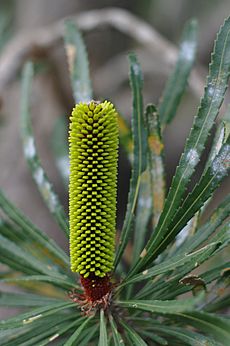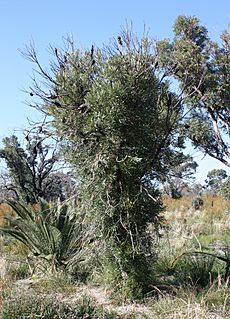Candlestick banksia facts for kids
Quick facts for kids Candlestick banksia or biara |
|
|---|---|
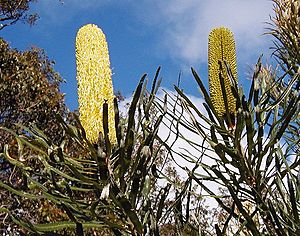 |
|
| B. attenuata, Margaret River | |
| Scientific classification | |
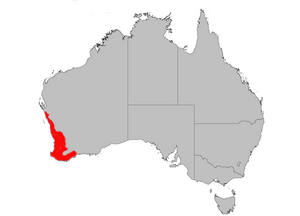 |
|
| distribution of Banksia attenuata | |
| Synonyms | |
The Banksia attenuata, often called the candlestick banksia, is a special plant found in Western Australia. The Noongar people, who are Indigenous Australians, call it biara. This plant is usually a tree that can grow up to 10 metres (33 feet) tall. But in drier places, it might be a smaller shrub, only 0.4 to 2 metres (1.3 to 6.6 feet) high.
It has long, narrow, saw-edged leaves and bright yellow flower spikes. These spikes stand tall above the leaves and appear in spring and summer. As the flowers get older, they turn grey and grow woody seed pods called follicles. The candlestick banksia grows across most of the southwest of Western Australia. You can find it from north of Kalbarri National Park down to Cape Leeuwin and over to Fitzgerald River National Park.
This banksia is very important for many animals in summer. Birds like honeyeaters and small honey possums visit its flowers. These animals help the plant make new seeds. The candlestick banksia can also survive bushfires. It regrows from a woody base called a lignotuber or from hidden buds in its trunk. Some of these plants can live for 300 years! People often plant them as street trees in Western Australia. There are even smaller versions you can buy for gardens.
Contents
What Does the Candlestick Banksia Look Like?
The candlestick banksia is usually a tree that can reach about 10 metres (33 feet) tall. In warmer, drier areas, it might be a shorter, bushy shrub between 0.4 and 2 metres (1.3 to 6.6 feet) high.
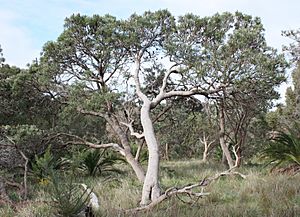
The tree forms have a strong trunk that is often wavy or bent. Its bark is orange-grey and crumbly, with a red-brown colour underneath. This plant can regrow after a fire from its woody base or from special buds hidden in its trunk.
Its leaves are long, narrow, and shiny green. They are about 4 to 27 centimetres (1.6 to 10.6 inches) long. The edges of the leaves have v- or u-shaped teeth. New leaves are a pale grey-green and mostly grow in late spring and summer, often after the plant has flowered.
The bright yellow flower spikes appear from spring to summer. They can be up to 5 centimetres (2 inches) wide and 25 to 30 centimetres (10 to 12 inches) tall. Each spike is made of many tiny flowers. These spikes grow at the ends of branches and stand out above the leaves. The flowers have a smell that some people compare to peppery wine.
As the flowers age, the spikes turn brown and then grey. The individual flowers shrivel up. Then, dark, furry, oval-shaped seed pods, called follicles, start to grow. These pods are about 2 to 3.5 centimetres (0.8 to 1.4 inches) long. Only a small number of flowers turn into these pods. The pods take about seven to eight months to grow and ripen.
How Was This Plant Named?
The first time Banksia attenuata was collected was in December 1801 by Robert Brown. He then officially described it in 1810. The name attenuata comes from a Latin word meaning "narrowed." This refers to how the leaves get narrower towards their base.
This plant's name has stayed mostly the same over time. There are no different types or subspecies of this plant. In 1840, another botanist, John Lindley, thought he found a new species and named it Banksia cylindrostachya. But it turned out to be the same plant that Robert Brown had already named. So, Brown's name was kept.
Common names for this plant include slender banksia, candle banksia, and candlestick banksia. The Aboriginal people in the Melville area of Perth call it Piara or biara.
Scientists have tried to figure out how Banksia attenuata is related to other plants in the Banksia group. Its exact family tree is still a bit unclear. However, it is known to be a very old type of banksia. An ancient fossil cone, about 50 million years old, looks very similar to the cones of B. attenuata.
Where Does the Candlestick Banksia Grow?
The candlestick banksia grows in many places across the southwest of Western Australia. You can find it from Kalbarri National Park in the north, all the way down to Augusta and Cape Leeuwin in the southwest. It also grows eastwards to the edge of Fitzgerald River National Park.
This plant prefers sandy soils, like white, yellow, or brown sands. It does not grow in heavy, clay-based soils. It is an important part of open Eucalyptus woodlands. It can be a main tree or a tall shrub growing under other trees. In northern areas, it often grows as a shrub in shrublands. The amount of rain in these areas ranges from 300 to 900 millimetres (12 to 35 inches) each year.
How Does It Survive and Thrive?
Like many plants in south-west Western Australia, the candlestick banksia is good at surviving bushfires. Some banksias die in fires but release their seeds to grow new plants. The candlestick banksia is different. It can survive fires by regrowing from its woody base (lignotuber) or from special buds hidden in its thick bark. Its seed pods can open during a fire or even later with rain.
Many of its seed pods do not open right after a fire. Instead, they wait for several autumn rains. This means the seeds are released when it's wetter, which helps them survive better. The seeds have special wings that move when wet or dry, slowly pulling the seed out of the pod.
Once the seeds are released, they grow best in temperatures between 15 and 20 degrees Celsius (59 and 68 degrees Fahrenheit). This timing helps them sprout during the autumn and winter rains, giving them the best chance to live. Even though many young plants might die in the hot, dry summer, the older plants can live for 300 years or more. This helps the population stay strong until there's a good year for new plants to grow.
Even though its seeds are quite heavy, they can travel far. Studies show that some plants can grow from seeds that came from up to 2.6 kilometres (1.6 miles) away. Scientists think that birds like the Carnaby's black cockatoo might help spread the seeds. These cockatoos look for banksia cones after fires, perhaps because the seeds are bigger and might have more grubs, making them a good food source. New flowers can appear just one or two years after a bushfire.
Uses and Cultural Significance
The flower spikes of the candlestick banksia are used in the cut flower industry, especially in Western Australia.
Aboriginal people, including the Nyoongar and Yamatji, used the flower spikes to make a sweet drink. They would put the spikes in a hole lined with paperbark and fill it with water.
Some people believe that this banksia, along with another type called B. aemula, inspired the famous "Big Bad Banksia Men" characters in May Gibbs' children's books, Snugglepot and Cuddlepie. May Gibbs knew this plant well from her childhood, which likely gave her the idea. A well-known artist named Marianne North also painted a beautiful picture of B. attenuata when she visited Australia in 1880–1881.
See also
 In Spanish: Banksia attenuata para niños
In Spanish: Banksia attenuata para niños


